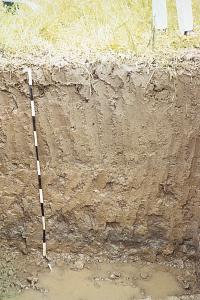Reference soil China 03: Anthrosol
Anthrosols occur over large areas in the Far East where growing of paddy rice takes place for centuries, in the Middle East where prolonged irrigation has been practised, and over small areas in western Europe and other parts of the world where long-time fertilization and earth-manuring have profoundly modified existing soils
Characteristics
Soils having either a hortic, irragric, plaggic or terric horizon 50 cm or more thick, or an anthraquic horizon and an underlying hydragric horizon with a combined thickness of 50 cm or more.
Reference soil CN003: Anthrosol
Deep, poorly drained, mottled, brown silt loam to silty clay, derived from alluvial deltaic deposits. Submergence and puddling has resulted in a porous massive topsoil abruptly overlying a massive plough pan. Organic carbon content is moderate. The subsoil shows weak to moderate angular blocky structures. Illuvial iron is present below 50cm. HYDROLOGY: until 1982 flooding by the Chang Jiang River occurred every 10 years with a submergence of 10-20cm depth; infiltration is estimated at 1-10cm/day; surface drainage is controlled by ditches at various levels of importance / HUMAN INFLUENCES: ploughing, until 1982 puddling; the land has been bunded in 1982 into parcels of about 2m wide; throughout the soil small pottery fragments occur.
|
WRB 2006: |
WRB 1998: |
||||||||
|
|
||||||||
|
|
|
FAO-UNESCO-ISRIC 1988: |
FAO-UNESCO 1974: |
||||||||||||||
|
|
||||||||||||||
|
|
Other classification
|
Classification (other) |
Recalcaric paddy soil; Gleyi-Stagnic Anthrosol |
Shanghai County, Quibao, First of July People's Commune
